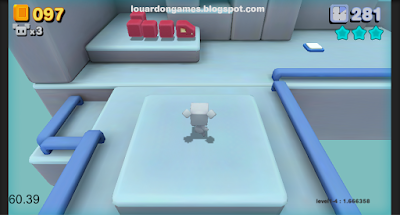
In this Lessons from Suzy Cube article, we are going to look at a section by section breakdown of one level currently in development for the game. Let's dive in!
When I first started studying the levels from Super Mario 3D Land, something quickly became apparent: Each level is a self contained collection of challenges focused around a particular game play mechanism which is mostly unique to that level.
Upon closer inspection, I began to notice a pattern emerging from level to level. It seemed to me that each level started by introducing the player to the particular mechanism that formed the core challenge of the level by presenting the player with a fairly simple and safe task, followed by one or two progressively more difficult and dangerous versions of the task.
The Narrative Structure of a Level
One of the ideas I've learned from working closely with level designers throughout my career is that a good level should be structured like a good story. In scrutinizing the levels in Super Mario 3D Land, the structure I thought I saw emerging reminded me of the narrative structure I learned in a college script writing class based on Syd Field's Paradigm:

The Syd Field Paradigm of narrative structure
This paradigm follows a traditional western narrative three act structure. The basic idea is that at the beginning of the first act, the author introduces the setting, the characters and gets the story going. By the end of the first act, we hit the first plot point in which something happens to set the main plot in motion. During act two, the story is developed through the main struggle or confrontation, it is the meat of the action. By the mid point, tensions are high and as the second act draws to a close, a second plot point reorients the story and sets things up for the conclusion. Finally, act three is when the story culminates to its climax before the author can take us down through the conclusion, hopefully, tying up the last few loose ends in the plot.
The way I had mapped the structure of Super Mario 3D Land levels onto this paradigm looked something like this:
Act 1
Introduce the setting of the level. Introduce the level's core mechanism with a safe and easy challenge. (e.g. safe from falls)
Act 2
Bring back the core mechanism with a similar challenge but with added danger. (e.g. over bottomless pit)
Act 3
One last challenge, ramp up the complexity and add even more danger. (e.g. added enemies to navigate around). This last challenge leads to the end of the level.
It turns out, the designers behind the game were, indeed, inspired by narrative structure, I was simply mistaken about which structure inspired them.
Four Acts are Better than Three?
According to this interview with the game's producer, Koichi Hayashida, the structure used to guide the design of the levels in Super Mario 3D Land is actually based on oriental four act narrative structure known, in Japan, as kishoutenketsu. It is the structure used, for example, in Japanese four panel comic strips and is comprised of the Introduction, Development, Twistand Conclusion. In the game, this breakdown can be used to describe a level like so:
Introduction
Set up a situation early in the level which forces the player to interact with the level's core mechanism without any danger.
Development (challenge 1)
Set up a tougher challenge centred around the core mechanism. This challenge also includes an element of danger, forcing the player to gain some mastery over the challenge or fail.
Twist (challenge 2)
A new challenge now faces the player. The core mechanism is the same but it's either used in a new way or in conjunction with new elements to mix things up.
Conclusion
One last use of the core mechanism to set up a challenge that should, at this point be pretty easy for the player, leaving them with a sense of accomplishment before reaching the end of the level.
Let's Apply What We've Learned
As I design levels for Suzy Cube, I try my best to keep this structure in mind. Some of my designs lean more toward the three act paradigm making use of two main challenge areas though I do try my best to think in terms of the kishoutenketsu or four act structure. So, let's have a closer look at a level from Suzy Cube and see how the different parts fit into this four act structure.

Map of Level 1-4
This is Level 1-4, it is a snow themed level centred around button activated temporary blocks and cannon which fire player seeking rockets. Roughly speaking, the layout of the level can be split into four parts like so:

Level 1-4 split into four parts
Let's dive deeper and look at each of these parts and how I try to make sure that each part prepares the player for what they will have to face later in the level.
Going in for a Closer Look

You start Level 1-4 surrounded by guardrails, hopefully, making it obvious which way to go. To the left you can see a snake enemy guarding some hidden coins. This enemy simply goes around on a set path and poses no threat to you unless you engage with it. To the right, a button on the floor is visible.






































